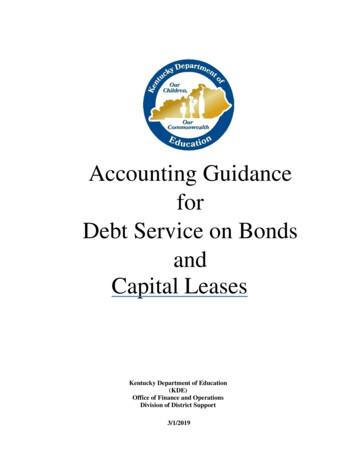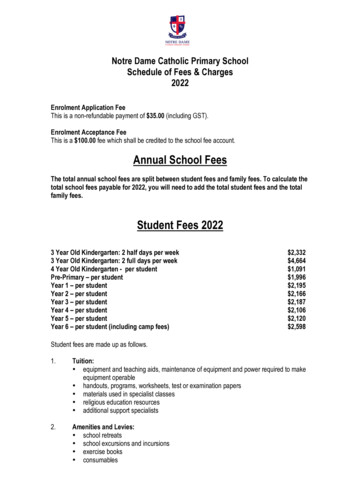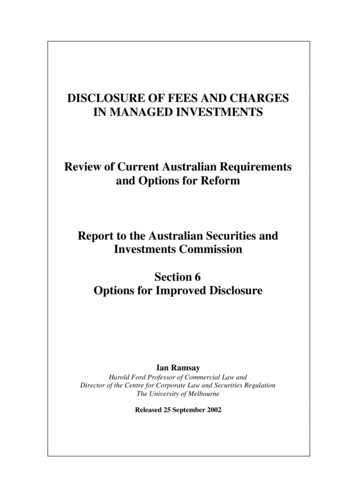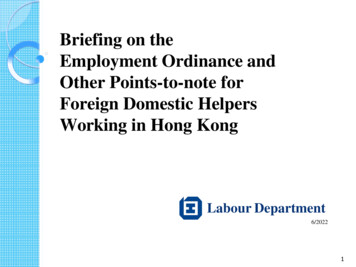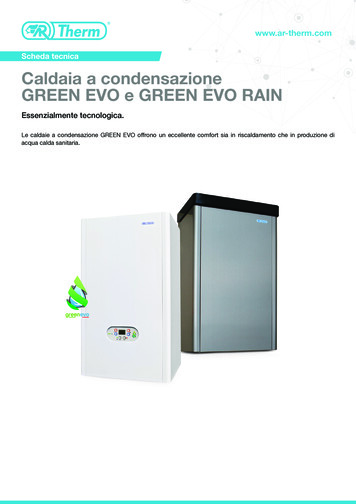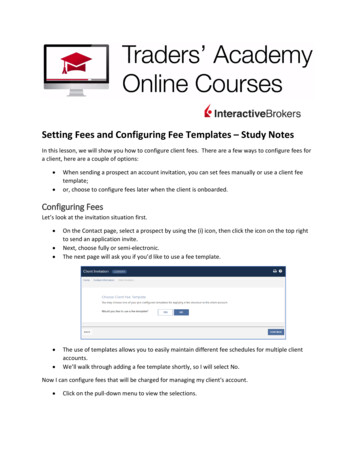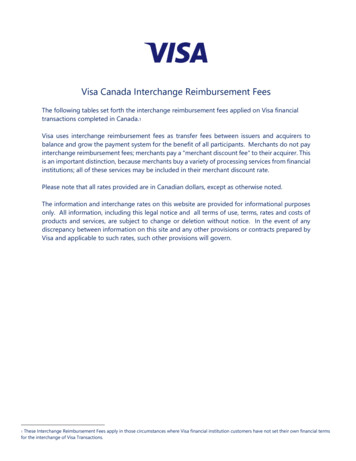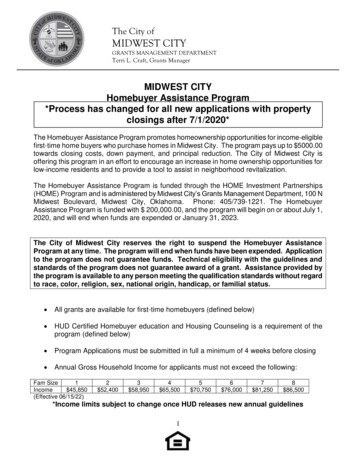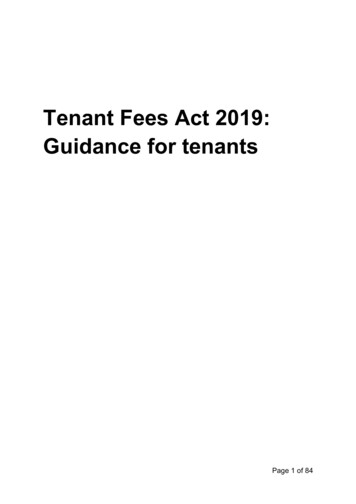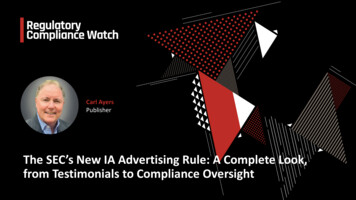
Transcription
W O R L DR E S O U R C E SI N S T I T U T EGREEN FEES:How a Tax Shift Can Work for theEnvironment and the EconomyROBERT REPETTOROGER C. DOWERROBIN JENKINSJACQUELINE GEOGHEGAN
GREEN FEES: HOW A TAX SHIFT CANWORK FOR THE ENVIRONMENT ANDTHE ECONOMYRobert RepettoRoger C. DowerRobin JenkinsJacqueline GeogheganW O R L DNovember 1992R E S O U R C E SI N S T I T U T E
Kathleen CourrierPublications DirectorBrooks ClappMarketing ManagerHyacinth BillingsProduction ManagerPamela ReznickCover PhotoEach World Resources Institute Report represents a timely, scientific treatment of a subject of public concern.WRI takes responsibility for choosing the study topics and guaranteeing its authors and researchers freedom ofinquiry. It also solicits and responds to the guidance of advisory panels and expert reviewers. Unless otherwisestated, however, all the interpretation and findings set forth in WRI publications are those of the authors.Copyright 1992 World Resources Institute. All rights reserved.ISBN 0-915825-76-7Library of Congress Catalog Card No. 92-085230Printed on Recycled Paper
ContentsAcknowledgmentsForewordI.vviiThe Potential Gains from Shifting theRevenue Burden from Economic "Goods"to Environmental "Bads"1A. The Burden of Today's Tax SystemB. The Economic (and Political) Benefitsof Environmental ChargesNotesII. Pay-By-The-Bag Household CollectionCharges to Manage Municipal SolidWasteA. Households' Response to WasteCollection ChargesB. Cost Savings Under Pay-by-the-BagSystems2712151719C. The Revenues and Net Savings fromWaste-Collection Charges2430A. A summary of the Empirical DemandModel30B. Estimated Coefficients32NotesA. Other CostsB. The TechnologyC. Estimated Benefits of UrbanCongestion Tolls AppliedNationwideD. Other CostsE. Projections to 1999F. Other ConsiderationsIV. Carbon Taxes to Reduce CO2Emissions1. The Costs of Solid Waste Collectionand Disposal192. Estimates of Solid-Waste Collectionand Disposal Costs22AppendicesIII. An Analysis of Tolls to ReduceCongestion on Urban Highways in theUnited States34A. Defining a Carbon TaxB. Setting the Right Level of a CarbonTaxC. Economic Consequences of CarbonTaxes35384041474849535456571. Macroeconomic Impacts of CarbonTaxes572. Recycling the Revenues593. What the Models Miss60D. Distributional Consequences ofCarbon Taxes1. The Impact of Energy Taxes byIncome Class2. The Impact of Energy Taxes byRegion3. The Impact of Carbon Taxes byIndustry61626367
E. The International Context for CarbonTaxes67Notes69V. Other Potential Environmental Charges . .71A. Effluent Charges741. Charges on Releases of ToxicSubstances Documented Under theToxic Release Inventory742. Vehicular Emissions Charges inAreas That Don't Meet Air QualityStandards753. Effluent Charges on Surface WaterDischarges76B. Activity ChargesRecreation Fees on the NationalForests and Other Public LandsIV7777C. Product Charges1. Additional Stratospheric OzoneDepleting Substances2. Agricultural Chemical Taxes787879D. Reducing Environmentally DamagingSubsidies and Tax Advantages811. Eliminating the Excess of PercentageOver Cost Depreciation for MineralExtraction Activities812. Charging Market Value forCommodities Produced on PublicLands82E. Conclusion83Notes84References85
AcknowledgmentsWe wish to thank numerous colleagues and friends who gavegenerously of their time, expertise,and encouragement at every step of this project. In particular we want to acknowledge thecareful research assistance of Robert Gramlichand Nazmul Chaudhury. From within WRI wethank Alan Brewster, Walter Reid, CarrieMeyer, James MacKenzie, and Rafe Pomerance,who provided generous and helpful comments.We also express our gratitude to colleaguesoutside of WRI including: Harry Kelejian,Doug Lee, Ken Small, and Phil Trostel. External reviews were provided by William Baumol,Dawn Erlandson, Richard Morgenstern, andRobert Shackleton. We appreciate their suggestions. Of course, we retain sole responsibilityfor the contents of this report.Our special thanks to Kathleen Courrier forher skillful editing of the report, to HyacinthBillings for her management of the productionprocess, to Allyn Massey for preparing thefigures, to Sue Terry for her help in obtainingnumerous reports and references, to our PolicyAffairs Program for the oversight and management of the distribution process, and to CindyBarger, Rosemary McCloskey, and EvaVasiliades for their assistance and coordinationat every stage.R.R.R.C.D.R.J.J-G
Forewordaxes, as the saying goes, are inevitable.But what governments tax is by nomeans inevitable. Today, the federalgovernment relies largely on personal and corporate income taxes and, increasingly, payrolltaxes (Social Security and Medicare). State andlocal governments also impose such taxes,along with sales, excise, and property taxes.Tused to reduce the federal deficit. The sumsthat can be generated through pollutioncharges and other green fees are potentiallyquite large, and they might well be politicallymore acceptable—or at least less unpalatable—than conventional taxes, since they would belinked directly to environmental improvementsthat Americans want.Taxes as now structured can assuredly havesome perverse effects on our economy by discouraging work, savings, and investment andby distorting economic decisionmaking. Cansome of our tax revenues be generated in aRobert Repetto, Roger C. Dower, RobinJenkins, and Jacqueline Geoghegan suggestthat the answer is yes. They recommend theuse of "green fees" such as charges on pollution, waste, and congestion. Substituting greenfees for some existing taxes would not onlyproduce a cleaner environment but would alsoreduce the economic disincentives of currenttaxes, thus strengthening the economy. Theproposition is straightforward: we should shiftsome of the U.S. tax burden from activities wewant to encourage—like working and investing—onto activities we want to discourage, likepollution, inefficiency, and waste. We shouldshift more from taxing "goods" to taxing"bads."Dr. Repetto and his co-authors illustrate theirpoint in detail by analyzing potential economicsavings from three readily adoptable taxeswhich give citizens and corporations an incentive to curb environmentally destructivebehavior: (1) pay-by-the-bag household collection charges to reduce the amount of solidwaste that municipalities must dispose of; (2)rush-hour tolls to reduce congestion and airpollution on urban highways; and (3) carbontaxes to reduce carbon dioxide emissions andencourage energy-efficiency. All told, theauthors estimate, these three environmentalcharges could yield at least 100 billion inannual revenues for federal, state, and localgovernments. These revenues would allowgovernments to reduce other, more distortionary taxes, producing net benefits to the U.S.economy. These revenues could also be usedto compensate citizens who are disproportionately hit by pollution charges, to pay forneeded environmental programs, or to reducegovernment deficits.The same reasoning would apply if the goalis to raise additional revenues, which could beEnvironmental taxes and fees are not theoretical inventions. In various forms, they havebetter way? In Green Fees: How a Tax Shift CanWork for the Environment and the Economy,VII
been enacted by individual states and localities(and by other countries) and found to be politically acceptable. Among the many possibilitiesare: effluent or emissions charges on a varietyof toxic chemicals; deposit-return charges onbatteries, tires, bottles, and other products;excise taxes on polluting products (e.g., gasoline, agricultural chemicals); and, not least,elimination of tax write-offs for environmentally damaging activities (e.g., groundwaterextraction, employee parking). According to theauthors, such charges work best when theactivities that cause an environmental problemare well understood, widely practiced, and easily monitored; when individual cost considerations differ but each unit of activity contributesmore or less proportionately to the overallproblem; and when the dynamics of the problem are changing too fast for a regulatory solution to be effective.Shifting the U.S. tax burden away from economic "goods" toward environmental "bads"would benefit the economy as a whole. Economic productivity and environmental protection are not incompatible. Indeed, the tax codecould become an instrument for enhancingboth at the same time.World Resources Institute's continuing series ofreports on options for revising tax policy andother economic incentives to curb pollution andwasteful energy use. This report's recommendations extend those of such previous WRIstudies as The Right Climate for Carbon Taxes:Creating Economic Incentives to Protect theAtmosphere; The Going Rate: What it Really Coststo Drive; and Driving Forces: Motor VehicleTrends and their Implications for Global Warming,Energy Strategies, and Transportation Planning.We would like to thank Alida Rockefeller forher support of our research on carbon taxesand the following foundations for their supportof this and other climate, energy, and pollutionprojects: Nathan Cummings Foundation; theGerman Marshall Fund of the United States;W. Alton Jones Foundation, Inc.; The JoyceFoundation; Charles Stewart Mott Foundation;The William Penn Foundation; Public WelfareFoundation, Inc.; and Rockefeller BrothersFund. We would also like to thank StephanSchmidheiny for his support of WRI's researchon pollution taxes generally. To all of these, weexpress our deep appreciation.James Gustave SpethGreen Fees: How a Tax Shift Can Work for theEnvironment and the Economy is the latest in theviuPresidentWorld Resources Institute
I. The Pbtential Gains from Shifting theRevenue Burden from Economic"Goods" to Environmental "Bads"The U.S. economy has been founderingin recession, fiscal deficits, and loss ofinternational competitiveness. Over thepast decade, output per worker in the UnitedStates has grown only half as fast as in the restof the industrialized world. Our productivitylead over our principal competitors is narrowing. The U.S. share in world manufacturingexports, meanwhile, has fallen by 20 percent ofits level in 1970. Unsatisfactory economic performance has exacerbated fears about the costsof meeting challenges to the quality of life andenvironment. In recent months, for example,economic concerns have undermined the U.S.Government's willingness to protect endangered species and old growth forests in thePacific Northwest, to protect the nation'swetlands from further encroachment, to implement stricter clean air standards, or to joinother nations in preventing potentially irreversible changes in the global climate. In each case,the choice has been cast as one between environmental protection and jobs or income. Theconflict is not limited to Washington, D.C. Inthe nation's cities and states, recession andrevenue deficits are making it difficult forauthorities to respond to deteriorating physicaland social infrastructure and acute urbanproblems.The resources with which to address thesedomestic and international problems are not athand. Americans already feel burdened bytaxes. Despite the anti-tax rhetoric of the pastdecade, government is taking a bigger bite, butU.S. capitalism is finding it harder and harderto deliver the rewards it so widely advertises.The typical family is struggling to maintainits living standards. Between 1971 and 1990,median family income adjusted for inflationrose only from 33,191 to 34,213, a gain ofonly 3 percent. For families below the median,the gains, if any, were even smaller. Economicimprovements over these years were achievedalmost entirely through increased work, mostlyby women, as the civilian labor force participation rate rose from 60 to 66 percent. For theemployed, average hourly inflation-adjustedearnings in private employment fell from 8.53in 1972 to 7.46 in 1991, and average weeklyearnings declined from 315 to 256. Comparedto 10 or even 20 years ago, the Americanpopulation is working harder and making less.At the same time, Uncle Sam is taking moreout of the average person's paycheck. Between1972 and 1990, personal income taxes andsocial security payroll taxes together have risenfrom 17.5 to 19.2 percent of personal income.Largely because of the rise in payroll taxes,most people have not seen any cut in the taxesthey pay. There is a widespread and notunfounded perception that tax cuts are only forthose with high-priced lawyers, accountants,and lobbyists.Most people feel that they are not gettingmuch for their tax dollars. Although the federalgovernment spends 1,400,000,000,000 every
year and state and local governments spend anadditional 800,000,000,000, the quality of education in the United States is comparativelypoor, access to health care and its cost areproblems, cities are unsafe, public infrastructure is deteriorating, environmental quality hasimproved little over time and, indeed, newglobal threats have emerged. Confidence inpoliticians and public administration is so lowthat most people are willing to shell out moremoney only if they are certain that it will beused effectively for purposes they support.For these reasons, taxes have becomeextremely controversial. But political debate hasdealt mainly with how much we tax, not whatwe tax. This is unfortunate, for what we tax isimportant. At present, our taxes fall mostly onjust those activities that make the economyproductive: work, savings, investment, andrisk-taking. Naturally, such taxes discouragepeople from undertaking these vital activities.A better system would place more of the taxburden on activities that make the economyunproductive and that should be discouraged:resource waste, pollution, and congestion, forexample. Taxes on these environmentally damaging activities would not distort economicdecisions, but rather would correct existingdistortions.A. The Burden of Today's TaxSystemAlmost all taxes have incentive and disincentive effects. Although economists talk of taxesthat don't affect behavior, "lump-sum taxes,"there are almost no practical examples. A taxon any good or service raises its cost to thebuyer while lowering the net after-tax receiptsto the seller. A tax gives the buyer an incentiveto cut back on what has become more expensive and to look around for a cheaper substitute. It induces the supplier to produce or offerless of the good or service for sale.Most federal taxes fall on income and profits.Of total tax receipts in 1991 of 1,120 trillion,41 percent came from the personal income tax,9 percent from corporate income taxes, and 42percent from payroll taxes. State and localgovernments rely more on sales, excise andproperty taxes, but 25 percent of their revenuesalso come from payroll taxes and personal andcorporate income taxes. Personal income taxesare mostly taxes on wages and salaries, and,for better off taxpayers, to some extent taxeson incomes from investments and capital gains.Corporate income taxes, to the extent they areultimately borne by stockholders, are also taxeson investments and capital gains.Taxes on wage and salary incomes, by lowering take-home pay, tend to discourage someworkers, who either withdraw from the laborforce or work fewer hours than they otherwisewould. These labor supply effects are mostpronounced among those women and elderlyand youthful workers whose commitment tofull-time employment is not iron-clad. At thesame time, of course, payroll taxes make workers more expensive to employers, and canprompt them to seek cheaper alternatives, suchas automating or moving operations overseas.Raising taxes on wage and salary incomes isan expensive way to raise government revenues because it reduces the economy's laborsupply. The more responsive labor supply is tochanges in after-tax wage rates, the greater theeconomic burden of income and payroll taxes.Taxes on income from investments have analogous economic costs. They lower the after-taxreturns from investments and thereby inducepeople to seek tax shelters or to save less. Aninflux of investments into such shelters has aneconomic cost because capital is withdrawnfrom other investments that have a higherbefore-tax rate of return.By reducing capital formation, a lower rate ofsavings has long-lasting and powerful effectson economic productivity and growth. Themore sensitive the savings rate is to the aftertax return on investments, the greater the economic cost of taxes on capital. This is not simply a matter of personal decisions about
savings. As world capital markets become morehighly integrated, it's ever more likely that anincrease in U.S. taxes on investment incomecould send U.S. savings abroad or reduce foreign investment in this country.Estimating these tax burdens is complicated.When the underlying issue is substituting environmental charges for conventional income andprofits taxes, the relevant measure is the gainfrom marginally reducing income and profitstaxes, when the revenues lost in this analysisare made up by higher environmental charges.For this reason, we can assume that the levelof government spending remains constant. Wecan further assume that shifts of the tax burden among taxpayers in various brackets canbe minimized through careful design of thepackage so that people's after-tax incomes willalso be unchanged. Under these assumptions,the problem becomes one of estimating what istechnically called the "marginal excess burden"of taxes.1In this light, consider first the tax on laborand income. Many attempts have been madeto measure the sensitivity of labor supply tothe after-tax wage appropriately2 for Americanmale and female workers, using both actuallabor market behavior and the results ofincome maintenance experiments. However,the numerical estimates still vary widely,according to the data sources, analyticalmodels, and econometric techniques used tomake the estimates. Table 1 summarizes thefindings of numerous studies. (Pencavel, 1986,pp. 5-102; and Killingsworth and Heckman,1986, pp. 103-200, Burtless, 1987)According to these studies, a 10-percent risein after-tax hourly earnings would induce a 1or 1.5 percent rise in hours worked, if after-taxincome were kept constant. For women, theresponse is greater, in the range of 3 to 6 percent, for the same percentage wage increase.Combining them, using the relative shares ofmen and women in total labor hours worked inthe United States as weights, suggests that aten percent rise in average hourly earningswould increase labor supply by roughly 2.5percent, income and other things equal.The problems in estimating the responsiveness of savings to changes in the interest ratesavers can earn are considerably more complex,and researchers have produced an even widerrange of estimates.4 Most studies of the excessburden of taxes on capital income have estimated that if tax rates on capital income wereraised ten percent, total savings would fall byfour percent, while recognizing that the marginal tax rates on different forms of investmentand savings differ substantially. (See Boskin,1986; Ballard, Shoven, and Whalley 1985, pp.128-138; Fullerton and Henderson 1989, pp.435-442; Jorgenson and Yun, 1990; Trostel,1991)These estimates have been used along withmeasures of marginal tax rates in severalstudies to determine the marginal excess burdens of taxes in the United States. Theseburdens are the additional loss of privateincome due to reductions in work effort andinvestment, on top of the direct tax payment.All studies come to two general conclusions:the burdens are high, and the burdens of taxesTable I. 3 Supply of Labor Elasticity EstimatesMaleFemaleNumberRangeMedianMean391110 to .840to20.10.290.110.57
on income from investments are higher thanthose on taxes on labor incomes.5 Table 2 summarizes several of these studies. They suggestthat the marginal excess burdens of payrolltaxes are about 0.30 to 0.50 for every extradollar of tax revenues collected thereby; thatthe marginal excess burdens of individualincome taxes are in a somewhat higher rangeof 0.40 to 0.60 per dollar of additionalrevenues collected, and that the marginalexcess burdens of taxes on income from investments are higher still, in the range of 0.60 to 1.20. Since some of these estimates weremade before the tax cuts of the 1980s, whichhave lowered marginal tax rates on manyincomes, the lower ends of these ranges areprobably more applicable today.These figures imply that government revenueneeds are currently met through taxes that areextremely costly to the United States economyin terms of lost work and savings. People feelburdened by taxes because taxes are indeedburdensome. If considerable governmentrevenues could be raised in non-distortingways, allowing reductions in taxes on income,payroll, and profits, the real economic savingswould be huge. Given the range of estimatesabove, substituting 100 billion of non-distorting taxes for a mix of current federal taxesyielding the same revenue might easily generate 40 to 60 billion yearly in additional realincome. This potential-tax reform dividend isas large as the much-heralded peace dividend.Government revenue needs are currentlymet through taxes that are extremelycostly to the United States economy interms of lost work and savings. Peoplefeel burdened by taxes because taxes areindeed burdensome.The distorting effects of the current tax structure have another important implication. Ifadditional revenue must be raised, either toreduce the federal government deficit or tofinance additional expenditures, then raising itby imposing non-distorting charges and taxesis much less burdensome on the economy thanincreasing tax rates on income, profits and payrolls. Environmental charges, which reduceeconomic distortions, can provide funds fordeficit reduction or expenditure needs at amuch lower cost than other tax options.The nation's cities and states stand to realizeeven greater economic gains through taxreform. Throughout the nation, most state andlocal governments are under severe fiscal pressure. Many have been facing budgetary crises.Since the mid-1980s, state and local government expenditures have outpaced revenues,undermining fiscal balances. The recessionaryTable 2. Marginal Excess Burden EstimatesTaxSocial Security Payroll"Individual IncomeInvestment Income0NumberRangeMedianMean223 0.31 to 0.48 0.40 to 0.60 0.58 to 1.18 0.40 0.50 0.92 0.40 0.50 0.88a. Ballard (1991) and Jorgenson and Yun (1990).b. Ballard (1991) and Jorgenson and Yun (1990).c. Jorgenson and Yun (1990), Ballard (1991), and Trostel (1991).
period just ending exacerbated the imbalance,eroding tax bases while increasing both thedemand for services and the costs of providingthem. During 1991, a projected budget gaptotalling 40 to 50 billion in all the statesnecessitated drastic actions. In 29 states, governments were forced to cut expenditures bymore than 7.5 billion, while enacting taxincreases totaling 10.3 billion. (NationalGovernors' Association, 1991) In 1992, thirtyfive states cut budgeted expenditures by a totalof 5.7 billion while raising 15 billion in newtaxes. (National Governors' Association, 1992)Further tax measures of this sort are expectedfor 1993.Most state governments have little flexibilityin dealing with these fiscal pressures. Laws orconstitutional provisions require balancedbudgets, even during recessions. Since statesalready rely heavily on sales taxes, opportunities to raise them further to offset declines inconsumer spending are limited. During fiscalyear 1991, over 40 percent of state revenueincreases came from personal and corporateincome taxes. (Belsie, 1990) Several states,including Alabama, New York, California,North Carolina, Minnesota, Missouri, Ohio,Texas, and Vermont, have already raised personal income taxes by a total exceeding 2 billion. Many states, including Alabama,Arkansas, Florida, Kentucky, North Carolina,Ohio, Rhode Island and Wisconsin, have raisedcorporate income taxes. (Dionne, 1991)These tax increases are measures of desperation. Besides the considerable marginal excessburdens that they create,6 they impose additional high costs on state economies. For thestate economy, the problem is not just that ahigher state personal income tax will inducesome workers to work less, it is also that thehigher state tax will induce some other workersto take jobs outside the boundaries of the state.Other things equal, states that impose hightaxes on their citizens' personal income willdiscourage immigration and encourage emigration. Thus, a governor's problem is not justthat a higher state tax on investment incomewill discourage savings. It will, but it will alsodiscourage investment within the boundaries ofthe state and encourage savings to flowelsewhere.Because labor is somewhat mobile and capitalis quite mobile among states, state governmentsinevitably find themselves in tax competitionwitness the panoply of special tax incentivesthey offer to attract new businesses. State andlocal taxes also enter the competition. Inevitably, states that raise their tax rates relative tothose in force in neighboring and competingstates are penalized. Of course, many households and firms are strongly tied to places andcommunities, and for those that do relocate,taxes are certainly not the only consideration.Nonetheless, overwhelming evidence indicatesthat state tax differentials influence the interstate movement of both capital and labor.Much of this evidence has been assessed in arecent study by Timothy Bartik on state andlocal economic development policies. Bartikreviewed 59 empirical studies of the effects ofstate and local taxes on inter-metropolitan orinterstate shifts in employment and businessinvestment. These studies vary significantly inhow they measure tax rates, differentials, andchanges; in how they measure changes inemployment or business location; and in howthey control for such other relevant factors asthe quality of public services and infrastructure. Accordingly, the results can be used onlyto establish plausible ranges for the responsesto higher state taxes.For example, five studies estimated theresponsiveness of state employment to stateand local income tax levels. (See the first panelof Table 3.) All five studies found that stateand local personal income taxes have substantial and statistically significant effects on employment growth within the state, clusteringaround an estimate of 3.9 percent decline inemployment for every ten percent rise in labortax rates. This indicates that jobs shift substantially among localities in response to state andlocal taxes.7
Bartik also reviewed studies measuring theeffects of state and local taxes on businessinvestment and location decisions. (See the second panel in Table 3.) Most of these studiescontrolled for general regional growth differentials and for differences among states in thelevel of public investment. Again, the weightof evidence supports the common-sense conclusion that higher state taxes discourage business investment within the state.and local taxes directly, all that can be said nowwith any certainty is that the efficiency losses tostate and local economies from state and localtaxes are substantially higher than the alreadyhigh marginal excess burdens of federal taxes.Along with serious revenue deficits, thesehigh losses of efficiency explain the search fortax alternatives in state government offices allacross the nation. For 1993, only 25 percent ofthe proposed tax increases come from personaland corporate income taxes. State governmentsseem far more willing than the federal government to impose "sin" taxes, user fees, and environmental charges. For 1993, over half of thenew tax revenues are to come from increases inalcohol and tobacco taxes, gasoline taxes andmotor vehicle registration fees, and other userfees. States already impose a wide variety ofcharges and fees related to environmental programs. Some states, notably Louisiana, SouthCarolina, and New Jersey, have proposed feeson hazardous waste processing facilities, feeson solid-waste facilities, and fees for emissionsdischarge inspections and control.For local and state economies, these studiesshow, increases in conventional taxes spell double trouble. They discourage work and savingsas federal taxes do, and they trigger the flightof labor and capital outside the tax jurisdiction.Since labor and capital are more likely to movein response to a change in incentives than towithdraw altogether from the economy, the economic loss to the state economy from a rise instate taxes, per dollar of revenue collected, islikely to be far greater than the loss to thenational economy per dollar of new federaltaxes. Since economists have not attempted tomeasure this marginal efficiency cost of stateTable 3. Labor and Capital Supply ElasticitiesEffectNumberTaxes on Labor Supply: elasticity ofemployment with respect to state andlocal individual income taxesTaxes on Capital Supply: elasticity ofbusiness location or investment withrespect to state and local corporateincome taxes11"RangeMedianMean-0.66 to -0.13-0.39-0.38-1.4 to 0.07-0.17-0.38Notes:a. Wasylenko (1988), Quan and Beck (1987), Carroll and Wasylenko (1989), Munnell (1990),Luce (1990).b. McConell & Schwab (1990), Woodward (1990), Bartik (1989), Bauer & Cromwell (1989),Deich (1989), Papke (1986, 1987, 1989), Schmenner, Huber & Cook (1987), Bartik (1985),Garofalo & Malhotra (1983), and Hodge (1981).
The logic of environmental charges forstate and local governments isespecially powerful. Since the qualityof life greatly influences wherehouseholds and businesses locate,environmental charges that can raiserevenues while improvingenvironmental quality are moreattractive than taxes that drivebusiness and workers away.The logic of environmental charges for stateand local governments is especially powerful.Since the quality of life greatly influenceswhere households and businesses locate, environmental
A. The Burden of Today's Tax System 2 B. The Economic (and Political) Benefits of Environmental Charges 7 Notes 12 II. Pay-By-The-Bag Household Collection Charges to Manage Municipal Solid Waste 15 A. Households' Response to Waste-Collection Charges 17 B. Cost Savings Under Pay-by-the-Bag Systems 19 1. The Costs of Solid Waste Collection and .
